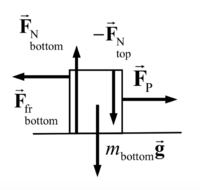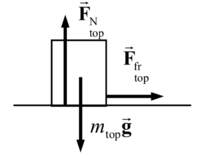Problem
A 4.0-kg block is stacked on top of a 12.0-kg block, which is accelerating along a horizontal table at  = 5.2 m/s
= 5.2 m/s . Let
. Let  .
.
(a) What minimum coefficient of friction  between the two blocks will prevent the 4.0-kg block from sliding off?
between the two blocks will prevent the 4.0-kg block from sliding off?
(b) If  is only half this minimum value, what is the acceleration of the 4.0-kg block with respect to the table, and...
is only half this minimum value, what is the acceleration of the 4.0-kg block with respect to the table, and...
(c) ...with respect to the 12.0-kg block?
(d) What is the force that must be applied to the 12.0-kg block in (a) and (b), assuming the table is frictionless?
Solution
(a)
4.0 kg block does not slide off : it has the same acceleration as the 12.0 kg block.


(b)
In this case, the block will slide, thus the friction will be kinetic



(c)
The bottom block is still accelerating to the right at 5.2 m/s . Since the top block has a smaller acceleration than that, it has a negative acceleration relative to the bottom block.
. Since the top block has a smaller acceleration than that, it has a negative acceleration relative to the bottom block.

2.6m/s to the left
to the left
(d)
No sliding:




This is the same as simply assuming that the external force is accelerating the total mass. The internal friction need not be considered if the blocks are not moving relative to each other.
Sliding:




Again this can be interpreted as the external force providing the acceleration for each block. The internal friction need not be considered.

















